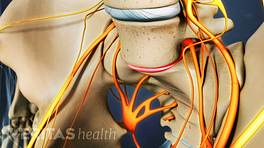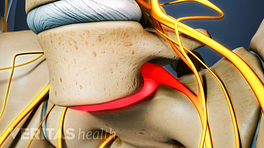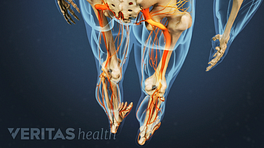When isthmic spondylolisthesis results in the irritation or impingement of a nerve root, it can result in sciatica pain. An exercise program that treats sciatica caused by isthmic spondylolisthesis will typically include a hybrid of flexion-based exercises and stabilization exercises.
The goal of this type of sciatica exercise program is to condition the lumbar spine to remain stable in a flexed position; therefore, the sciatica treatment exercises for isthmic spondylolisthesis are a combination of both programs.
Let’s do the pelvic tilt. Pelvic tilt is an important technique because it is the basis of many of the other exercises we will be doing later. To begin the pelvic tilt, lay on your back. Keep your knees bent with your feet flat on the floor. Now think about pulling your belly button in towards your spine. Your back will automatically flatten towards the floor. As you pull your belly button in, your pelvis will roll up towards your chest. Be very careful not to push with your legs to make your pelvis roll. This is a position you will hold while you are performing many of the other exercises.
The hook-lying march exercise helps with lumbar stabilization. Begin by lying on your back and start with performing a pelvic tilt. Keep your knees bent and slowly raise one leg at a time only an inch or two. The goal here is to do this without rolling your pelvis side to side. And if you lock your pelvis in position, it should stay fairly straight. It may be easier to monitor your pelvic motion by placing your fingers behind your pelvis.
You should be able to speak while doing these exercises, so you are not overworking yourself. If you are having a hard time raising the entire leg without moving your pelvis, begin by just raising one heel at a time and alternate.
To advance the hook-lying march exercise, perform the same leg movement but keep your arms straight up towards the ceiling. Now lock your pelvis in position, and as you raise your left leg, drop your right arm down over your head. Return to the starting position, and alternate sides. Don’t let your pelvis tilt up or arch your back. Your back should stay relatively still while performing these exercises.
Let’s perform abdominal curl-ups. Begin by lying on your back with your knees bent up. Fold your arms across your chest and perform a posterior pelvic tilt. Curl up lifting your head and shoulders from the floor straight towards the ceiling. Hold for 2 to 4 seconds, then slowly lower to the starting position. Do not attempt to lift the head up too high. As strength builds, aim to complete 2 sets of 10 curls.
For patients with neck pain, place your hands behind the head to support the neck. Be careful not to lift your head with your hands.










